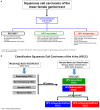Molecular Subtypes of Vulvar Squamous Cell Carcinoma: The Significance of HPV-Independent/p53 Wild Type
- PMID: 39766115
- PMCID: PMC11674125
- DOI: 10.3390/cancers16244216
Molecular Subtypes of Vulvar Squamous Cell Carcinoma: The Significance of HPV-Independent/p53 Wild Type
Abstract
Vulvar carcinoma is a rare disease, meeting the criteria for a "rare cancer", but its incidence is increasing, especially in women <60 years of age. Squamous cell carcinoma (VSCC) accounts for the overwhelming majority of vulvar carcinomas and is the focus of this review. As with many cancers, the increased understanding of molecular events during tumorigenesis has led to the emergence of the molecular subclassification of VSCC, which is subclassified into tumors that arise secondary to high-risk human papillomavirus infection (HPV-associated, or HPVa) and those that arise independently of HPV (HPVi), most commonly in the setting of a chronic inflammatory condition of the vulvar skin. This latter group of HPVi VSCC arises in most cases secondary to mutations in TP53, but recently, attention has focused on the uncommon TP53 wild-type HPVi VSCC. These three molecular subtypes of VSCC (HPVa, HPVi p53 abnormal, and HPVi p53 wild type), as well as their precursor lesions, cannot be diagnosed based on a routine histopathological examination or immunostaining for p53 and p16 as surrogate markers for TP53 mutation and high-risk HPV infection, respectively, are required. The molecular subtyping of VSCC shows high reproducibility and provides important prognostic information. HPVa VSCC has the most favorable prognosis, while HPVi VSCC with TP53 mutations (p53abn) has the worst prognosis, and HPVi VSCC with wild-type TP53 (p53wt) has an intermediate prognosis. In this review, we discuss the evidence supporting this molecular subclassification and its implications for the diagnosis and treatment of VSCC and its precursors.
Keywords: classification; human papillomavirus; molecular; p16; p53; prognosis; radiation therapy; squamous cell carcinoma; surgery; vulvar cancer.
Conflict of interest statement
The authors declare no conflict of interest.
Figures








References
Publication types
LinkOut - more resources
Full Text Sources
Research Materials
Miscellaneous

